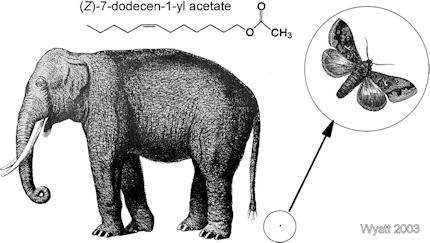
|
I am interested in how pheromones evolve and in particular the parallels between chemical communication in invertebrates and in vertebrates. One of the intriguing things is the way that some small molecules occur in a number of insects and vertebrates (Kelly 1996; Wyatt 2014); for example variations of the terpene brevicomin are used by male house mice and some bark beetle species (Novotny 2003), and the Asian elephant female pheromone, (Z)-7-dodecen- 1-yl acetate is a component of the female pheromone blend of some 140 species of moth (above), and the Asian male elephant’s pheromone frontalin is also used by some bark beetles (Rasmussen et al. 2003). The use of the same molecules may reflect some constraints on the number of low molecular weight molecules that are volatile, stable and relatively non-toxic. Animals also share a common ancestry and thus their biochemical pathways, which will also shape the range of molecules available for evolution to act on. Visitors I would be happy to explore hosting visiting researchers bringing their own funding to complete a writing project, on sabbatical for example. |
|

